Enhanced Subspace Iteration Technique for Probabilistic Modal Analysis of Statically Indeterminate Structures
Abstract
1. Introduction
2. Theoretical Development
2.1. Subspace Iteration Method for Vibration Modal Computation
2.2. Extended Subspace Iteration Method Using FDP
- (1)
- Construct an initial subspace matrix using Equations (37) and (38).
- (2)
- For the -th iteration, calculate the new eigenvector matrix using Equation (35) as follows:
- (3)
- Calculate the condensed stiffness matrix and mass matrix through:
- (4)
- Solve the simplified eigen-pair problem of the reduced system to obtain the corresponding eigenvalues and eigenvectors as follows:
- (5)
- For the -th iteration, the solution of the eigenvalues of the random system are the first diagonal elements of . The solution of the eigenvectors is the first column vector obtained through:
- (6)
- The iteration can be terminated when the results of two adjacent iterations are very close.
3. Numerical Examples
3.1. Example 1: A Truss Structure
3.2. Example 2: A Beam Structure
4. Conclusions
Author Contributions
Funding
Data Availability Statement
Conflicts of Interest
References
- Men, P.; Wang, X.; Liu, D.; Zhang, Z.; Zhang, Q.; Lu, Y. On use of polyvinylpyrrolidone to modify polyethylene fibers for improving tensile properties of high strength ECC. Constr. Build. Mater. 2024, 417, 135354. [Google Scholar] [CrossRef]
- Peng, X.; Shi, F.; Yang, J.; Yang, Q.; Wang, H.; Zhang, J. Modification of construction waste derived recycled aggregate via CO2 curing to enhance corrosive freeze-thaw durability of concrete. J. Clean. Prod. 2023, 405, 137016. [Google Scholar] [CrossRef]
- Zhang, G.Z.; Liu, C.; Cheng, P.F.; Li, Z.; Han, Y.; Wang, X.Y. Enhancing the Interfacial Compatibility and Self-Healing Performance of Microbial Mortars by Nano-SiO2-Modified Basalt Fibers. Cem. Concr. Compos. 2024, 152, 105650. [Google Scholar] [CrossRef]
- Clough, R.W.; Penzien, J.P. Dynamics of Structures; McGraw–Hill: New York, NY, USA, 1993. [Google Scholar]
- Bathe, K.J. Finite Element Procedures; Prentice–Hall: Upper Saddle River, NJ, USA, 1996. [Google Scholar]
- Dong, B.; Parker, R.G. Sector-model subspace iteration for vibration of multi-stage, cyclically symmetric systems. J. Sound Vib. 2023, 544, 117378. [Google Scholar] [CrossRef]
- Xu, H.; Liu, B. Hierarchical subspace evolution method for super large parallel computing: A linear solver and an eigensolver as examples. Int. J. Numer. Methods Eng. 2023, 124, 5–39. [Google Scholar] [CrossRef]
- Friswell, M.I.; Garvey, S.D.; Penny, J.E.T. Model reduction using dynamic and iterated IRS techniques. J. Sound Vib. 1995, 186, 311–323. [Google Scholar] [CrossRef]
- Lin, Y.; Simoncini, V. A new subspace iteration method for the algebraic Riccati equation. Numer. Linear Algebra Appl. 2015, 22, 26–47. [Google Scholar] [CrossRef]
- Gu, M. Subspace iteration randomization and singular value problems. SIAM J. Sci. Comput. 2015, 37, A1139–A1173. [Google Scholar] [CrossRef]
- Lasecka-Plura, M.; Lewandowski, R. The subspace iteration method for nonlinear eigenvalue problems occurring in the dynamics of structures with viscoelastic elements. Comput. Struct. 2021, 254, 106571. [Google Scholar] [CrossRef]
- Chen, S.H.; Yang, X.W.; Lian, H.D. Comparison of several eigenvalue reanalysis methods for modified structures. Struct. Multidiscip. Optim. 2000, 20, 253–259. [Google Scholar]
- Chen, S.H.; Yang, X.W. Extended Kirsch combined method for eigenvalue reanalysis. AIAA J. 2000, 38, 927–930. [Google Scholar] [CrossRef]
- Kirsch, U. Approximate vibration reanalysis of structures. AIAA J. 2003, 41, 504–511. [Google Scholar] [CrossRef]
- Kirsch, U.; Bogomolni, M. Procedures for approximate eigenproblem reanalysis of structures. Int. J. Numer. Methods Eng. 2004, 60, 1969–1986. [Google Scholar] [CrossRef]
- Yang, Z.J.; Chen, S.H.; Wu, X.M. A method for modal reanalysis of topological modifications of structures. Int. J. Numer. Methods Eng. 2006, 65, 2203–2220. [Google Scholar] [CrossRef]
- Hong, S.-K.; Epureanu, B.I.; Castanier, M.P.; Gorsich, D.J. Parametric reduced-order models for predicting the vibration response of complex structures with component damage and uncertainties. J. Sound Vib. 2011, 330, 1091–1110. [Google Scholar] [CrossRef]
- Xu, T.; Guo, G.; Zhang, H. Vibration reanalysis using frequency-shift combined approximations. Struct. Multidiscip. Optim. 2011, 44, 235–246. [Google Scholar] [CrossRef]
- Norouzi, M.; Nikolaidis, E. Efficient method for reliability assessment under high-cycle fatigue. Int. J. Reliab. Qual. Saf. Eng. 2012, 19, 1250022. [Google Scholar] [CrossRef]
- Mourelatos, Z.P.; Nikolaidis, E. An efficient re-analysis methodology for vibration of large-scale structures. Int. J. Veh. Des. 2013, 61, 86–107. [Google Scholar] [CrossRef]
- Zheng, S.P.; Wu, B.S.; Li, Z.G. Vibration reanalysis based on block combined approximations with shifting. Comput. Struct. 2015, 149, 72–80. [Google Scholar] [CrossRef]
- Liu, H.; Wang, H.; Tan, G.; Liu, Z. Reanalysis of the structural dynamic characteristics based on double coordinate free-interface mode synthesis & matrix perturbation method. Vibroengineering Procedia 2016, 10, 83–88. [Google Scholar]
- Li, D.; Zhou, Q.; Chen, G.; Li, Y. Structural dynamic reanalysis method for transonic aeroelastic analysis with global structural modifications. J. Fluids Struct. 2017, 74, 306–320. [Google Scholar] [CrossRef]
- Zheng, S.P.; Wu, B.S.; Li, Z.G. Free vibration reanalysis of structures with added degrees of freedom. Comput. Struct. 2018, 206, 31–41. [Google Scholar] [CrossRef]
- Huang, G.; Chen, X.; Yang, Z.; Wu, B. Exact analysis and reanalysis methods for structures with nonlinear boundary conditions. Comput. Struct. 2018, 198, 12–22. [Google Scholar] [CrossRef]
- He, J.; Chen, X.; Xu, B. Structural modal reanalysis for large, simultaneous and multiple type modifications. Mech. Syst. Signal Process. 2015, 62, 207–217. [Google Scholar]
- He, J.; Xu, B. Quick and Highly Efficient Modal Analysis Method Based on the Reanalysis Technique for Large Complex Structure and Topology Optimization. Int. J. Comput. Methods 2020, 17, 1850134. [Google Scholar] [CrossRef]
- Chang, S.; Cho, M. Dynamic-condensation-based reanalysis by using the Sherman–Morrison–Woodbury formula. AIAA J. 2021, 59, 905–911. [Google Scholar] [CrossRef]
- Li, W.; Chen, S. An improved model order reduction method for dynamic analysis of large-scale structures with local nonlinearities. Appl. Math. Model. 2023, 120, 786–811. [Google Scholar] [CrossRef]
- Yang, Q.W. Fast and Exact Algorithm for Structural Static Reanalysis Based on Flexibility Disassembly Perturbation. AIAA J. 2019, 57, 3599–3607. [Google Scholar] [CrossRef]
- Yang, Q.W.; Peng, X. A Fast Calculation Method for Sensitivity Analysis Using Matrix Decomposition Technique. Axioms 2023, 12, 179. [Google Scholar] [CrossRef]
- Koh, H.S.; Yoon, G.H. Ritz vector-based substructuring method using interface eigenmode-shape pseudo-forces. Finite Elem. Anal. Des. 2023, 227, 104023. [Google Scholar] [CrossRef]
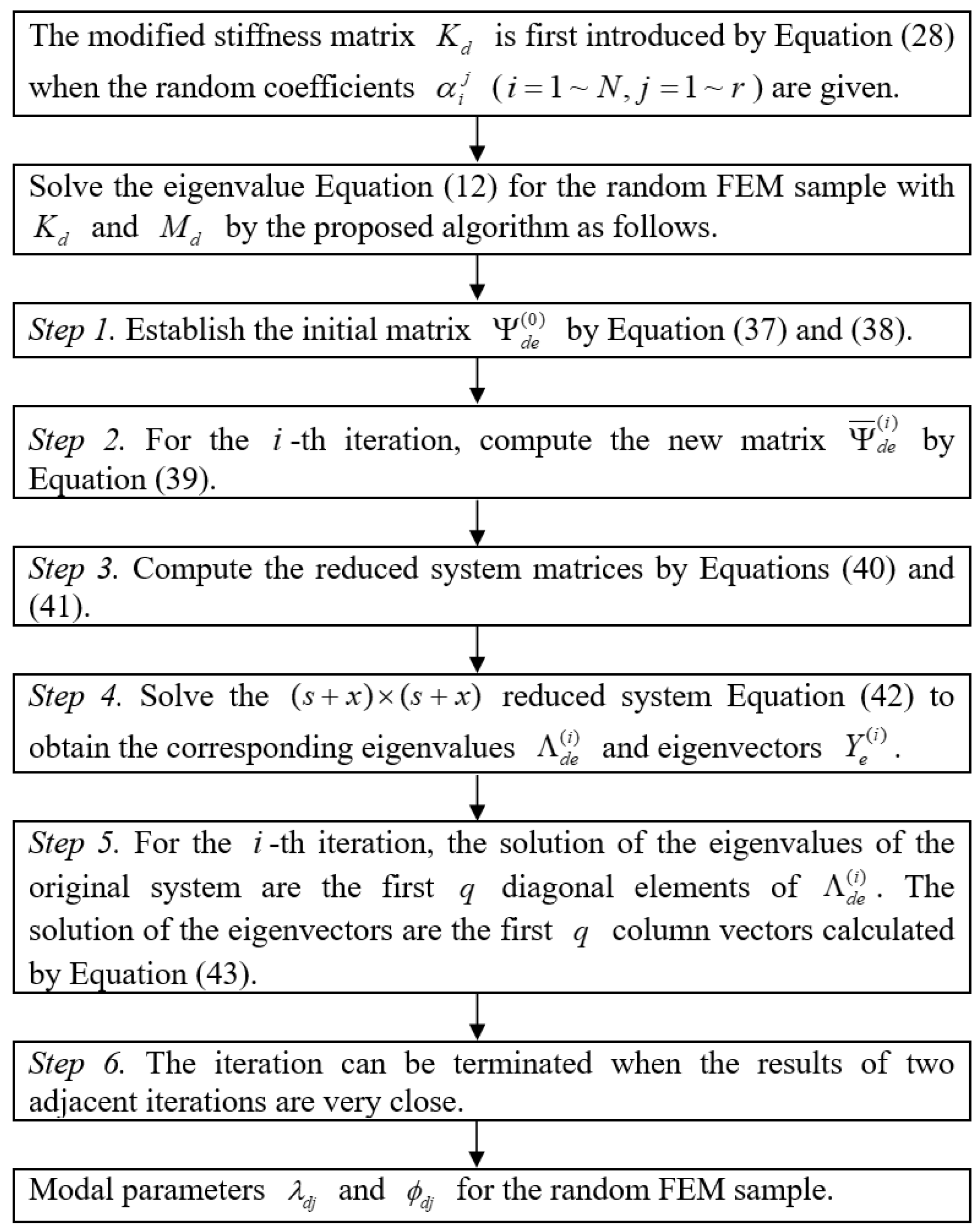
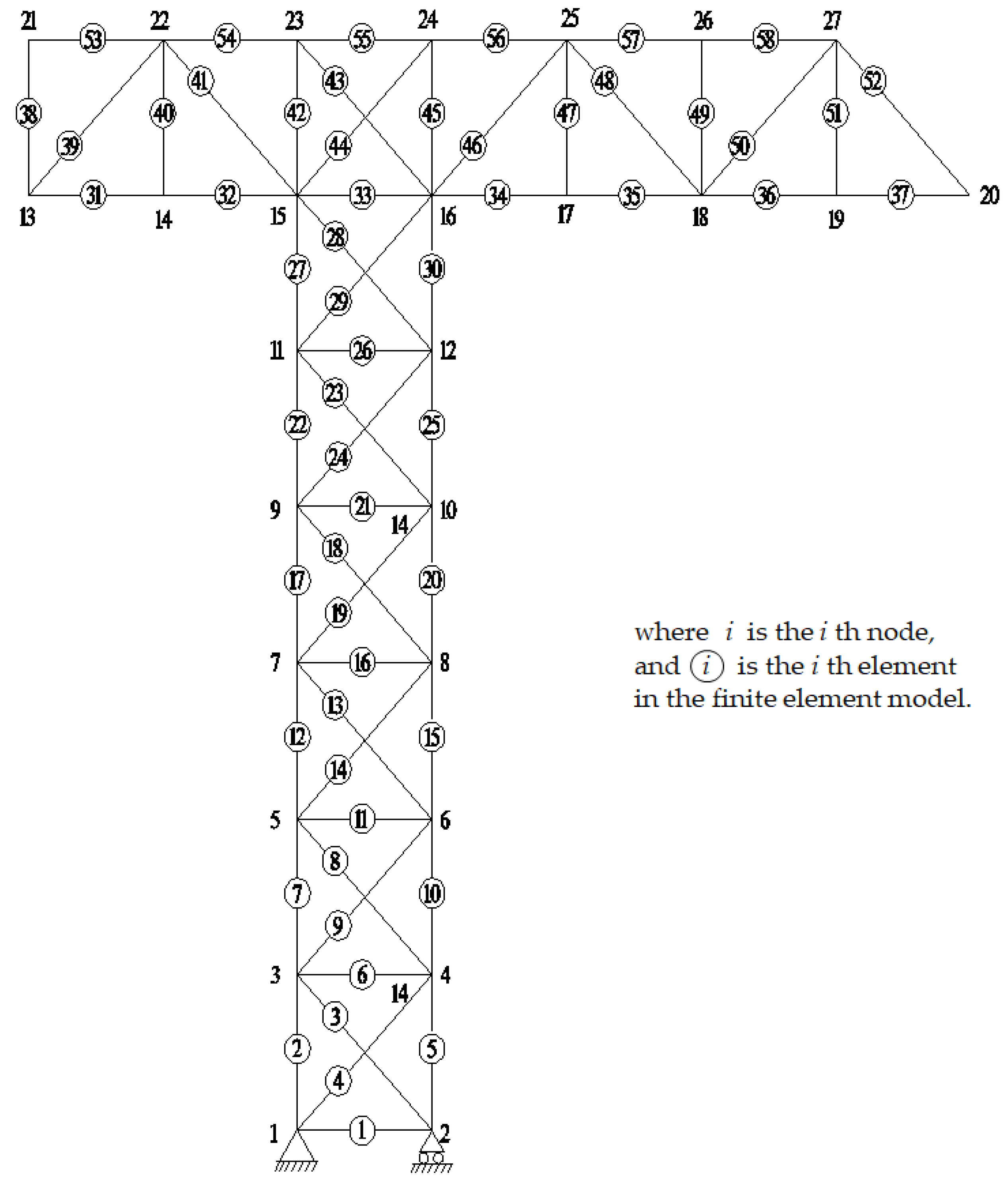

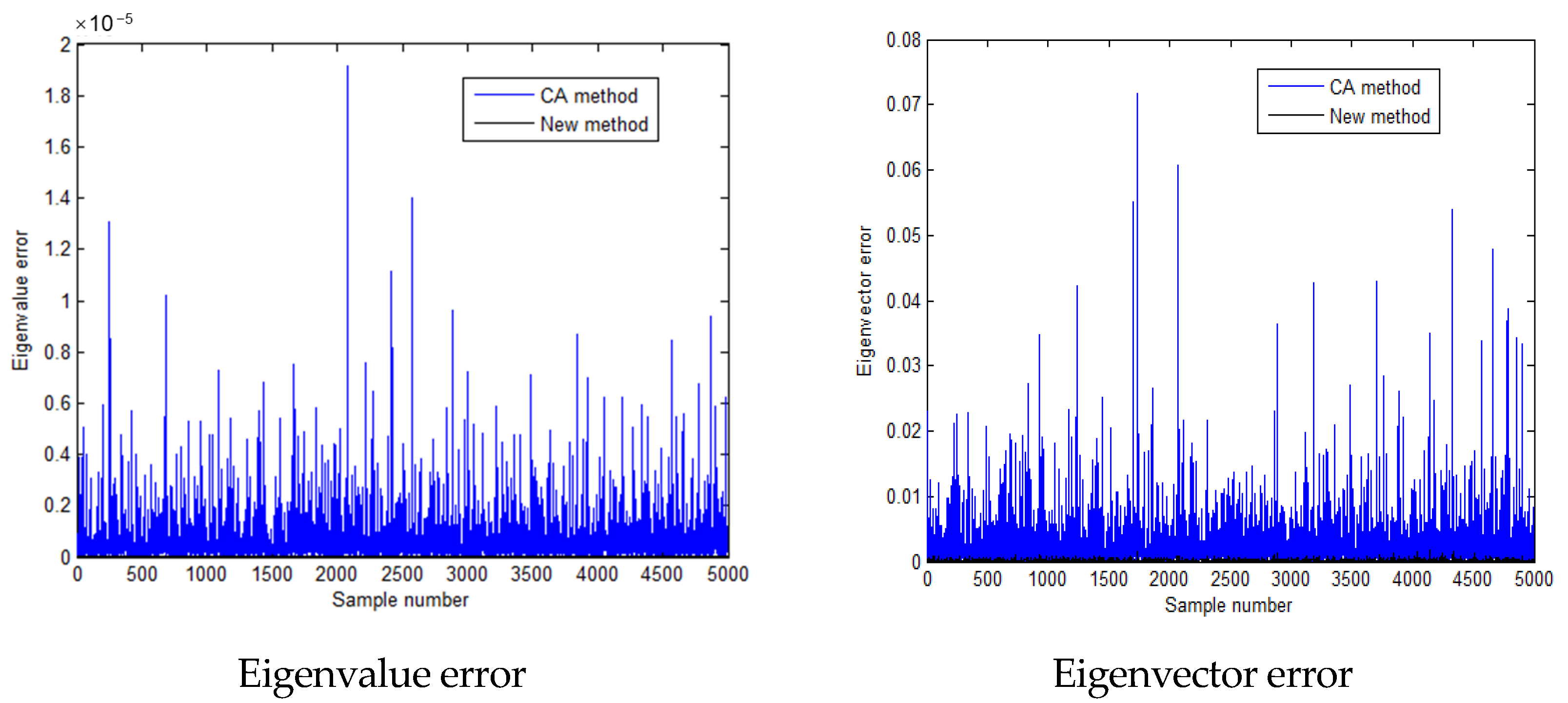



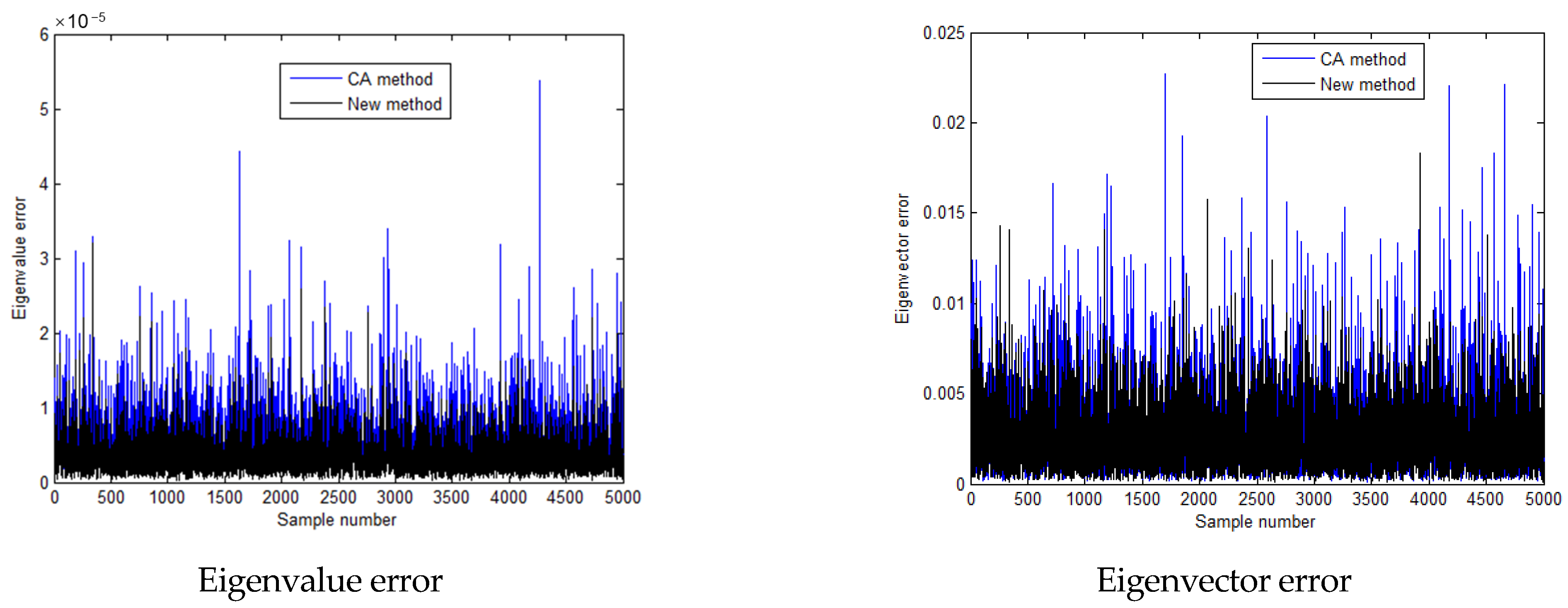



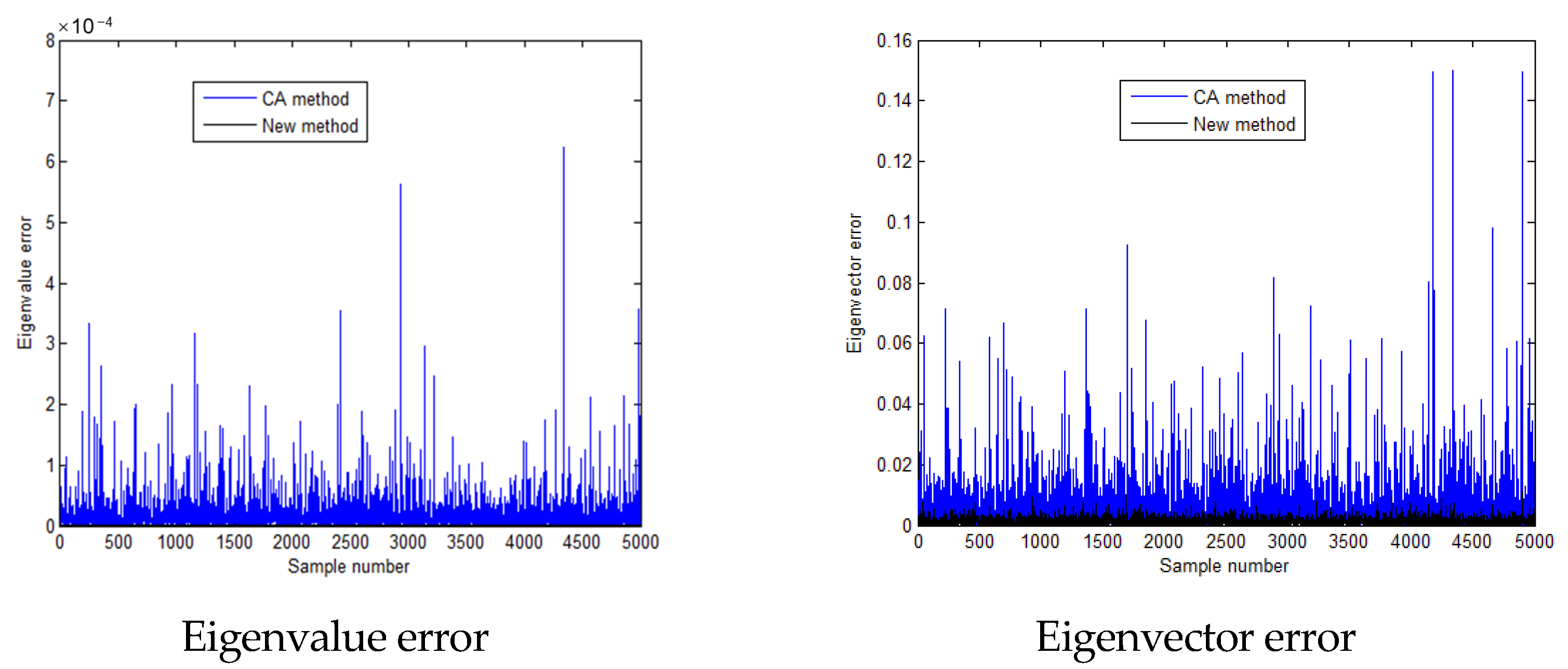



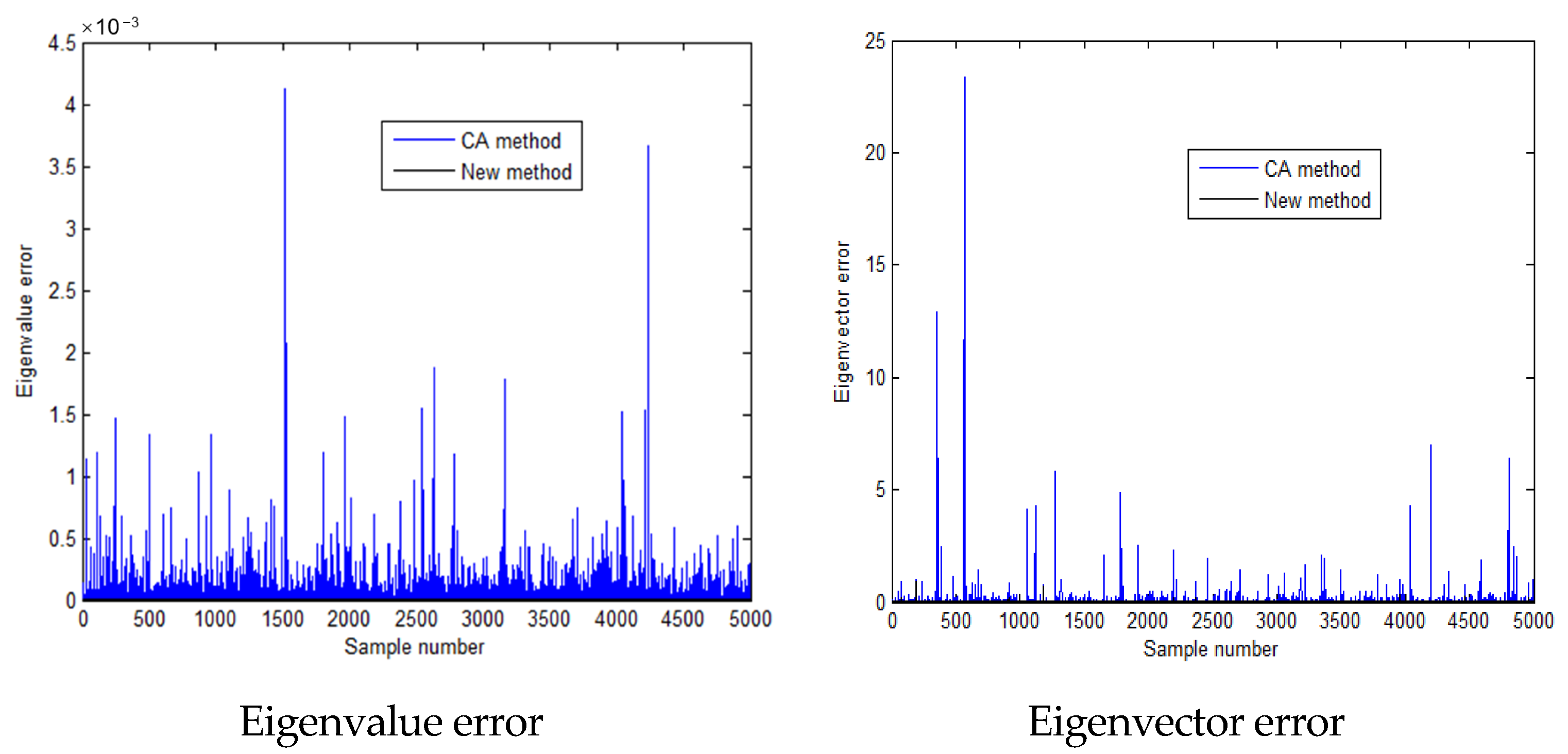

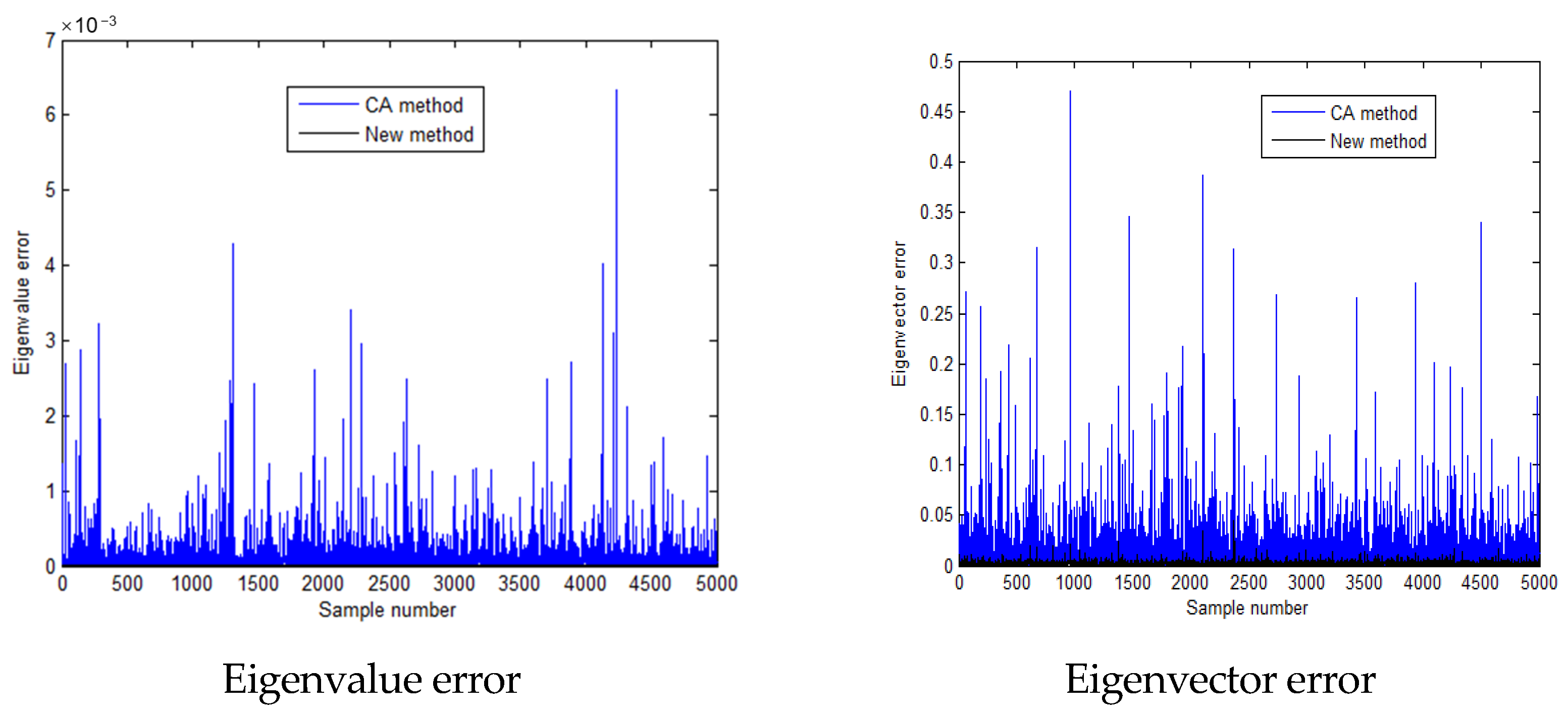



| Method | ) | ) | ) |
|---|---|---|---|
| Time/s | = 43.53 -- -- | = 0.794 = 1.8% -- | = 0.516 = 1.2% = 65% |
| Method | Complete Analysis | CA Method | New Method |
|---|---|---|---|
| Range (×104) | [1.0222, 1.3519] | [1.0222, 1.3519] | [1.0222, 1.3519] |
| Mean (×104) | 1.1873 | 1.1873 (0.00%) * | 1.1873 (0.00%) |
| Standard deviation | 455.4689 | 455.4677 (0.00%) | 455.4689 (0.00%) |
| Method | Complete Analysis | CA Method | New Method |
|---|---|---|---|
| Range (×105) | [1.2779, 1.6027] | [1.2779, 1.6027] | [1.2779, 1.6027] |
| Mean (×105) | 1.4233 | 1.4233 (0.00%) | 1.4233 (0.00%) |
| Standard deviation | 4751.3 | 4751.3 (0.00%) | 4751.3 (0.00%) |
| Method | Complete Analysis | CA Method | New Method |
|---|---|---|---|
| Range (×105) | [6.1859, 7.7367] | [6.1860, 7.7367] | [6.1860, 7.7367] |
| Mean (×105) | 6.8872 | 6.8873 (0.00%) | 6.8873 (0.00%) |
| Standard deviation | 21,122 | 21,122 (0.00%) | 21,122 (0.00%) |
| Method | ) | ) | ) |
|---|---|---|---|
| Time/s | = 44.163 -- -- | = 0.853 = 1.9% -- | = 0.513 = 1.2% = 60% |
| Method | Complete Analysis | CA Method | New Method |
|---|---|---|---|
| Range (×104) | [0.9264, 1.4296] | [0.9264, 1.4296] | [0.9264, 1.4296] |
| Mean (×104) | 1.1755 | 1.1755 (0.00%) | 1.1755 (0.00%) |
| Standard deviation | 691.9361 | 691.9117 (0.00%) | 691.9361 (0.00%) |
| Method | Complete Analysis | CA Method | New Method |
|---|---|---|---|
| Range (×105) | [1.1772, 1.6882] | [1.1774, 1.6883] | [1.1772, 1.6882] |
| Mean (×105) | 1.4097 | 1.4097 (0.00%) | 1.4097 (0.00%) |
| Standard deviation | 7174.3 | 7174.0 (0.00%) | 7174.3 (0.00%) |
| Method | Complete Analysis | CA Method | New Method |
|---|---|---|---|
| Range (×105) | [5.8076, 8.1225] | [5.8077, 8.1229] | [5.8076, 8.1226] |
| Mean (×105) | 6.8165 | 6.8167 (0.00%) | 6.8166 (0.00%) |
| Standard deviation | 31,844 | 31,843 (0.00%) | 31,844 (0.00%) |
| Method | ) | ) | ) |
|---|---|---|---|
| Time/s | = 45.084 -- -- | = 0.794 = 1.8% -- | = 0.529 = 1.2% = 67% |
| Method | Complete Analysis | CA Method | New Method |
|---|---|---|---|
| Range (×104) | [0.7571, 1.4768] | [0.7582, 1.4769] | [0.7571, 1.4768] |
| Mean (×104) | 1.1577 | 1.1577 (0.00%) | 1.1577 (0.00%) |
| Standard deviation | 963.8251 | 963.5571 (0.03%) | 963.8249 (0.00%) |
| Method | Complete Analysis | CA Method | New Method |
|---|---|---|---|
| Range (×105) | [1.0349, 1.8033] | [1.0359, 1.8035] | [1.0349, 1.8033] |
| Mean (×105) | 1.3884 | 1.3886 (0.01%) | 1.3884 (0.00%) |
| Standard deviation | 9786.9 | 9782.2 (0.05%) | 9786.9 (0.00%) |
| Method | Complete Analysis | CA Method | New Method |
|---|---|---|---|
| Range (×105) | [4.9208, 8.6974] | [4.9642, 8.6985] | [4.9240, 8.6975] |
| Mean (×105) | 6.7002 | 6.7013 (0.02%) | 6.7003 (0.00%) |
| Standard deviation | 42,387 | 42,353 (0.08%) | 42,387 (0.00%) |
| Scenario | The Ratios of the Standard Deviations to the Means for the First Three Eigenvalues | ||
|---|---|---|---|
| The First Eigenvalue | The Second Eigenvalue | The Third Eigenvalue | |
| The standard deviation of the elastic modulus is 0.1 times the mean value | 0.038 | 0.033 | 0.031 |
| The standard deviation of the elastic modulus is 0.15 times the mean value | 0.059 | 0.051 | 0.047 |
| The standard deviation of the elastic modulus is 0.2 times the mean value | 0.083 | 0.070 | 0.063 |
| Scenario | |||
|---|---|---|---|
| The elastic moduli of the first 30 elements are treated as random variables | = 198.39 -- -- | = 9.10 = 4.6% -- | = 4.42 = 2.2% = 48.6% |
| The elastic moduli of the first 60 elements are treated as random variables | = 200.14 -- -- | = 8.83 = 4.4% -- | = 4.35 = 2.2% = 49.3% |
| The elastic moduli of all elements are treated as random variables | = 229.17 -- -- | = 9.81 = 4.3% -- | = 4.59 = 2.0% = 46.8% |
| Method | Complete Analysis | Ritz Vector Method | New Method |
|---|---|---|---|
| Range (×105) | [0.9695, 1.2268] | [0.9702, 1.2268] | [0.9701, 1.2268] |
| Mean (×105) | 1.1919 | 1.1919 (0.00%) * | 1.1919 (0.00%) |
| Standard deviation | 2031.9 | 2028.3 (0.18%) | 2029.2 (0.13%) |
| Method | Complete Analysis | Ritz Vector Method | New Method |
|---|---|---|---|
| Range (×105) | [1.2651, 1.4406] | [1.2652, 1.4407] | [1.2652, 1.4407] |
| Mean (×105) | 1.3524 | 1.3524 (0.00%) | 1.3524 (0.00%) |
| Standard deviation | 2662.4 | 2660.8 (0.06%) | 2661.2 (0.05%) |
| Method | Complete Analysis | Ritz Vector Method | New Method |
|---|---|---|---|
| Range (×105) | [1.4802, 1.7036] | [1.4854, 1.7038] | [1.4837, 1.7037] |
| Mean (×105) | 1.5991 | 1.5992 (0.01%) | 1.5992 (0.01%) |
| Standard deviation | 2010.3 | 2008.0 (0.11%) | 2008.6 (0.08%) |
| Method | Complete Analysis | Ritz Vector Method | New Method |
|---|---|---|---|
| Range (×105) | [0.8629, 1.2717] | [0.8648, 1.2717] | [0.8644, 1.2717] |
| Mean (×105) | 1.1647 | 1.1648 (0.01%) | 1.1648 (0.01%) |
| Standard deviation | 3845.8 | 3842.1 (0.10%) | 3842.9 (0.08%) |
| Method | Complete Analysis | Ritz Vector Method | New Method |
|---|---|---|---|
| Range (×105) | [1.2080, 1.4541] | [1.2081, 1.4544] | [1.2081, 1.4543] |
| Mean (×105) | 1.3423 | 1.3424 (0.01%) | 1.3424 (0.01%) |
| Standard deviation | 2940.0 | 2938.2 (0.06%) | 2938.9 (0.04%) |
| Method | Complete Analysis | Ritz Vector Method | New Method |
|---|---|---|---|
| Range (×105) | [1.4252, 1.6981] | [1.4261, 1.6983] | 1.4260, 1.6983] |
| Mean (×105) | 1.5773 | 1.5775 (0.01%) | 1.5775 (0.01%) |
| Standard deviation | 3834.7 | 3830.7 (0.10%) | 3831.5 (0.08%) |
| Method | Complete Analysis | Ritz Vector Method | New Method |
|---|---|---|---|
| Range (×105) | [0.8364, 1.2925] | [0.8369, 1.2926] | [0.8369, 1.2926] |
| Mean (×105) | 1.1456 | 1.1458 (0.02%) | 1.1458 (0.02%) |
| Standard deviation | 4203.0 | 4199.5 (0.08%) | 4200.6 (0.06%) |
| Method | Complete Analysis | Ritz Vector Method | New Method |
|---|---|---|---|
| Range (×105) | [1.1000, 1.4688] | [1.1004, 1.4689] | [1.1003, 1.4689] |
| Mean (×105) | 1.3140 | 1.3143 (0.02%) | 1.3142 (0.02%) |
| Standard deviation | 4363.5 | 4361.5 (0.05%) | 4361.9 (0.04%) |
| Method | Complete Analysis | Ritz Vector Method | New Method |
|---|---|---|---|
| Range (×105) | [1.3585, 1.7274] | [1.3589, 1.7277] | [1.3589, 1.7277] |
| Mean (×105) | 1.5523 | 1.5526 (0.02%) | 1.5526 (0.02%) |
| Standard deviation | 4971.5 | 4969.8 (0.03%) | 4970.3 (0.02%) |
| Scenario | The Ratios of the Standard Deviations to the Means for the First Three Eigenvalues | ||
|---|---|---|---|
| The First Eigenvalue | The Second Eigenvalue | The Third Eigenvalue | |
| The elastic moduli of the first 30 elements are treated as random variables | 0.017 | 0.020 | 0.013 |
| The elastic moduli of the first 60 elements are treated as random variables | 0.033 | 0.022 | 0.024 |
| The elastic moduli of all elements are treated as random variables | 0.037 | 0.033 | 0.032 |
Disclaimer/Publisher’s Note: The statements, opinions and data contained in all publications are solely those of the individual author(s) and contributor(s) and not of MDPI and/or the editor(s). MDPI and/or the editor(s) disclaim responsibility for any injury to people or property resulting from any ideas, methods, instructions or products referred to in the content. |
© 2024 by the authors. Licensee MDPI, Basel, Switzerland. This article is an open access article distributed under the terms and conditions of the Creative Commons Attribution (CC BY) license (https://creativecommons.org/licenses/by/4.0/).
Share and Cite
Cao, H.; Peng, X.; Xu, B.; Qin, F.; Yang, Q. Enhanced Subspace Iteration Technique for Probabilistic Modal Analysis of Statically Indeterminate Structures. Mathematics 2024, 12, 3486. https://doi.org/10.3390/math12223486
Cao H, Peng X, Xu B, Qin F, Yang Q. Enhanced Subspace Iteration Technique for Probabilistic Modal Analysis of Statically Indeterminate Structures. Mathematics. 2024; 12(22):3486. https://doi.org/10.3390/math12223486
Chicago/Turabian StyleCao, Hongfei, Xi Peng, Bin Xu, Fengjiang Qin, and Qiuwei Yang. 2024. "Enhanced Subspace Iteration Technique for Probabilistic Modal Analysis of Statically Indeterminate Structures" Mathematics 12, no. 22: 3486. https://doi.org/10.3390/math12223486
APA StyleCao, H., Peng, X., Xu, B., Qin, F., & Yang, Q. (2024). Enhanced Subspace Iteration Technique for Probabilistic Modal Analysis of Statically Indeterminate Structures. Mathematics, 12(22), 3486. https://doi.org/10.3390/math12223486








